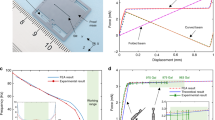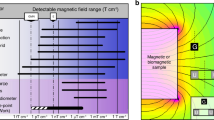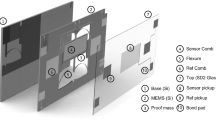Abstract
A PAIR of sensitive Pirani gauges, set up in this laboratory for another purpose, was found to be remarkably sensitive to small magnetic fields. It seemed worth while to give a report of the phenomenon, which may be of interest to those working in the field of thermomagnetic effects. The gauges consist each of a thin nickel strip, 12 cm. long and 0·003 mm. by 0·05 mm. in cross-section. They are mounted parallel and about 2 cm. apart in a high vacuum, and are connected in two of the arms of a Wheatstone bridge, the other two arms being fixed resistances.
This is a preview of subscription content, access via your institution
Access options
Subscribe to this journal
Receive 51 print issues and online access
$199.00 per year
only $3.90 per issue
Buy this article
- Purchase on Springer Link
- Instant access to full article PDF
Prices may be subject to local taxes which are calculated during checkout
Similar content being viewed by others
References
L. E. Knott, Trans. Roy. Soc. Edinburgh, 41, 39; 1903. ibid., 45, 547; 1907.
Author information
Authors and Affiliations
Rights and permissions
About this article
Cite this article
McMILLAN, E. A Magnetic Effect on Pirani Gauges using Nickel Wires. Nature 133, 831–832 (1934). https://doi.org/10.1038/133831b0
Issue Date:
DOI: https://doi.org/10.1038/133831b0
Comments
By submitting a comment you agree to abide by our Terms and Community Guidelines. If you find something abusive or that does not comply with our terms or guidelines please flag it as inappropriate.



